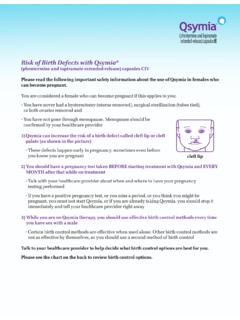Transcription of Overview - Qsymia REMS
1 Overview The Food and Drug Administration (FDA) has required a Risk Evaluation and Mitigation Strategy (REMS). for Qsymia to ensure the benefits of Qsymia outweigh the increased risk of teratogenicity. Purpose The purpose of the REMS is to inform prescribers, pharmacies, and females of reproductive potential (FRP) about the: Increased risk of congenital malformations, specifically orofacial clefts, in infants exposed to Qsymia during the first trimester of pregnancy Importance of pregnancy prevention for FRP. Need to discontinue Qsymia immediately if pregnancy occurs Complete the Qsymia Pharmacy Certification in 3 easy steps: 1.
2 Read through the entirety of this Pharmacy Training Program and confirm you understand the program's content by completing the knowledge assessment questions. For mail order pharmacies, your knowledge assessment may be completed by the Authorized Pharmacy Representative (AR) and faxed to the Qsymia REMS Pharmacy Support Center at 1-855-302-6699. For chain pharmacies, your knowledge assessment responses may be managed by your Authorized Pharmacy Representative. Please contact your corporate Authorized Pharmacy Representative for instructions on completing your knowledge assessment For independent pharmacies, your knowledge assessment may be completed and faxed to the Qsymia REMS Pharmacy Support Center at 1-855-302-6699.
3 2. Complete Pharmacy Enrollment Form and provide to the Qsymia REMS Pharmacy Support Center at 1-855-302-6699. For chain pharmacies, a Pharmacy Enrollment Form must be completed by the Authorized Representative for the corporate chain organization For chain pharmacy dispensing locations, a Pharmacy Enrollment Form must be completed by the Responsible Pharmacist, and can be obtained from the Authorized Representative for the corporate chain organization For independent pharmacies, a Pharmacy Enrollment Form is required for the Authorized Pharmacy Representative for the dispensing pharmacy location For mail order pharmacies.
4 An Enrollment Form must be completed by the Authorized Representative for the mail order pharmacy organization 3. Complete the vendor verification/validation process. Upon successful completion of your program training, knowledge assessment and certification form, you will receive instructions on how to complete the vendor verification steps to verify your pharmacy management system is successfully connected to the Qsymia REMS network for all Qsymia claims and dispenses. (This does not apply to Mail Order pharmacies.). 1. Step 1: Complete Pharmacy Training Program Including Knowledge Assessment These training materials are being provided to assist pharmacists with understanding the risks of Qsymia and the pharmacy requirements under the REMS.
5 Before you are eligible to dispense Qsymia , it is important to be aware of the increased risk of teratogenicity associated with Qsymia therapy. The information presented in this Training Program does not include a complete list of all risks and safety information on Qsymia . Before dispensing Qsymia , please read the accompanying Qsymia Prescribing Information, Qsymia Medication Guide, and the Risk of Birth Defects with Qsymia patient brochure. Further information is also available on the Web site, or by calling Qsymia REMS Pharmacy Support Center at 1-855-302-6698. Indication and Patient Selection Qsymia is indicated as an adjunct to a reduced-calorie diet and increased physical activity for chronic weight management in adult patients with an initial body mass index (BMI) of: 30 kg/m2 or greater (obese), or 27 kg/m2 or greater (overweight) in the presence of at least one weight-related comorbidity such as hypertension, type 2 diabetes mellitus, or dyslipidemia Limitations of use.
6 The effect of Qsymia on cardiovascular morbidity and mortality has not been established The safety and effectiveness of Qsymia in combination with other products intended for weight loss, including prescription and over-the-counter drugs, and herbal preparations, have not been established 2013-2014 VIVUS Inc. All rights reserved. RE-03-018-01 08/2014. 2. Increased Risk of Teratogenicity Qsymia is classified as Pregnancy Category X. Qsymia is contraindicated in pregnant women because the use of Qsymia can cause fetal harm. Available data indicate an increase in oral clefts (cleft lip with or without cleft palate) in infants exposed to topiramate, one of the components of Qsymia , during the first trimester of pregnancy Studies evaluating the risk of major congenital malformations and/or oral clefts with exposure to topiramate, a component of Qsymia , during pregnancy include the following: The North American Anti-Epileptic Drug (NAAED) Pregnancy Registry (2010) analysis A retrospective evaluation of a Wolters Kluwer claims database (January 2003-December 2010 from the United States).
7 A retrospective observational study using 4 electronic healthcare databases (FORTRESS). A case-control study using data from the Slone Epidemiology Center Birth Defects Study (BDS, 1997- 2009) and the Centers for Disease Control's (CDC's) National Birth Defects Prevention Study (NBDPS, 1996-2007). The NAAED Pregnancy Registry suggested an estimated increase in risk for oral clefts of (95% CI ). An increase in oral clefts was observed with all dose strengths of topiramate. SUMMARY OF STUDIES EVALUATING THE ASSOCIATION. OF TOPIRAMATE IN UTERO EXPOSURE AND ORAL CLEFTS. ORAL CLEFTS MAJOR CONGENITAL MALFORMATIONS.
8 EPIDEMIOLOGY. STUDY PREVALENCE/ 95% CI ESTIMATED 95% CI. ODDS RATIO INCREASE IN RISK. WOLTERS KLUWERa FORTRESSa SLONE/CDC a Sponsored by the maker of Qsymia (phentermine and topiramate extended-release) capsules CIV. CI=con dence interval. These data show that exposure to topiramate, a component of Qsymia , in pregnancy is associated with a 2- to 5-fold increase in risk of oral clefts. Other data sources confirm the increased risk of oral clefts with topiramate exposure during pregnancy (ie, animal studies and Adverse Event Reporting System data). 3. Counseling Provided by HCPs for Females of Reproductive Potential*.
9 Qsymia can cause fetal harm. Advise females of reproductive potential that labeling recommends: Pregnancy testing prior to beginning Qsymia and monthly during therapy. Specific documentation of the result is not required at the pharmacy level Use of effective contraception consistently during Qsymia therapy because Qsymia can cause certain kinds of birth defects (oral clefts). Even females who believe they cannot become pregnant should use effective contraception while taking Qsymia due to the potential for increased fertility associated with weight loss If a patient becomes pregnant while taking Qsymia , Qsymia should be discontinued immediately and the patient advised to notify their healthcare provider * Females of reproductive potential are women who have NOT.
10 Had a hysterectomy, bilateral oophorectomy, or medically documented spontaneous ovarian failure, and have not gone through menopause. Menopause should be clinically confirmed by an individual's healthcare provider. Advise nursing mothers not to use Qsymia . Qsymia may be present in human milk because topiramate and amphetamines (phentermine has pharmacologic activity and a chemical structure similar to amphetamines) are excreted in human milk. 2013-2014 VIVUS Inc. All rights reserved. RE-03-018-01 08/2014. 4. Qsymia is only dispensed through Certified Pharmacies Under the REMS, Qsymia is only available through certified pharmacies.



![Sample Appeal Letter [Name of Payer] [Address Re …](/cache/preview/e/6/8/5/b/7/3/d/thumb-e685b73d6344044c7bf20606c28370b9.jpg)
